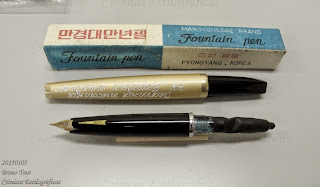-- Lemonsha’s branch in Shinjuku no longer carries fountain pens. That part of the business is now concentrated in the Ginza shop.
-- Map Camera-Kingdom Note, therefore, is the only available shop for second hand pens in Shinjuku. However, the selection of those –as of February 2015— is becoming alarmingly small, which combined with the usually high prices of this shop make this pen scenario not very appealing. Map Camera/Kingdom Note keeps having a very good inventory of inks (at MSRP prices).
And it is my impression that the second hand market is moving away from regular shops. The amount of pen on display on them seems to be shrinking. The trade might be moving to some other channels, probably eliminating the middle man.
-- Mori-ichi in Ginza-Kyobashi has been refurbished and no longer sells with discounted prices and its appeal is now very low. This shop stocks mostly Pilot pens.
-- Isetan department store in Shinjuku has enlarged its space for fountain pens. As in any other department store in town, all pens are marked at MSRP, and no bargains can be really found in them. This section has a small selection of maki-e decorated pens.
All in all, I want to see an increase on the importance of the fountain pen market—on this last reform of Isetan in Shinjuku, fountain pens have gained some importance.
Isetan Shinjuku
Shinjuku 3-14-1
Shinjuku
Tokyo 160-0022
Tel: 03 3352 1111
Hours: 10:30-20:00
-- Angers Bureau seemed to be a stationer and gift shop with a few fountain pens here and there, but nothing very interesting. However, now it is possible to see some vintage pens on display. Given their prices, they seem to be more of a decoration than an actual new product in their line of business. Some pen rookie might fall for them, though. Anyway, all this might be the result of a renewed interest in fountain pens.
Angers Bureau has three shops in Tokyo:
ANGERS Ravissant Shinjuku (Marui building)
Shinjuku 3-30-13, Marui Honkan 8F
Shinjyuku
Tokyo 160-022
Tel 03 3352 1678
Hours: 11:00-21:00
ANGERS Bureau ecute (Ueno JR Station)
Ueno 7-1-1, ecute 3F
Taito
Tokyo 110-0005
Tel: 03 5826 5681
Hours: 18:00-22:00
ANGERS Bureau Marunouchi (KITTE building)
Marunouchi, 2-7-2, KITTE 4F
Chiyoda
Tokyo 100-0005
Tel: 03 3217 2006
Hours: 11:00-21:00
Pilot Custom 912, music nib – Sailor Yama-dori
Bruno Taut
Shinjuku, February 13th, 2015
etiquetas: Tokyo, mercado
Bruno Taut
Shinjuku, February 13th, 2015
etiquetas: Tokyo, mercado









































